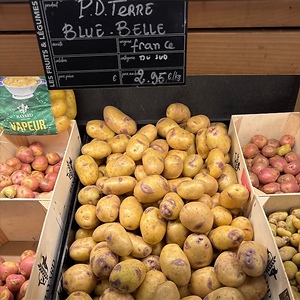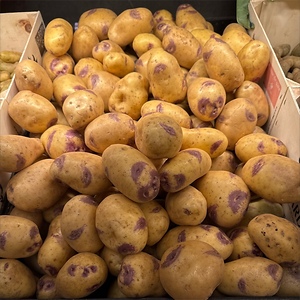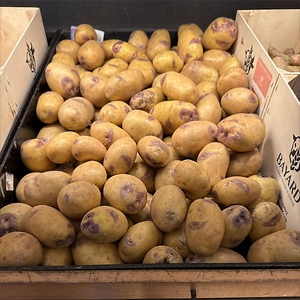


Blue Belle Potatoes
Estimated Inventory, lb : 0
Description/Taste
Blue Belle potatoes are medium to large tubers and have a uniform, oval shape with blunt curved ends. The skin is smooth, semi-thick, and firm with a golden yellow base, showcasing distinct, blue-purple spots of varying sizes around the shallow eyes. Underneath the surface, the flesh ranges from pale yellow to ivory and is fine-grained and smooth with a dense, primarily waxy consistency. When cooked, Blue Belle potatoes have a moderate starch content, developing a mild, earthy, and slightly sweet flavor.
Seasons/Availability
Blue Belle potatoes are available in the early fall through winter.
Current Facts
Blue Belle potatoes, botanically classified as Solanum tuberosum, are an early to mid-season variety belonging to the Solanaceae family. The waxy tubers were one of the first bi-colored potatoes created in France and are considered an all-purpose variety, used in a wide assortment of culinary applications. Blue Belle potatoes also produce moderate yields and are resistant to some diseases and cracking, becoming a valued variety in home gardens and for commercial growers. In France, the tubers are favored for their mild taste and are often marketed as a “happy potato,” showcasing unique, “purple smiles” on the skin.
Nutritional Value
Blue Belle potatoes are an excellent source of vitamin C, an antioxidant that strengthens the immune system, reduces inflammation, and boosts collagen production within the skin. The tubers are also a good source of vitamin B6 to develop neurotransmitters and provide smaller amounts of iron, phosphorus, manganese, and fiber.
Applications
Blue Belle potatoes are best suited for cooked applications, including roasting, baking, frying, mashing, and boiling. The tubers can be cooked with the skin on and hold their shape fairly well when heated as the moderate starch content creates a soft but still firm texture. Blue Belle potatoes can be roasted as a savory side dish, or they can be baked whole and covered in toppings as an accompaniment to roasted meats. The tubers can also be incorporated into stews, soups, and curries, boiled and quartered for salads, or sliced and fried as a crisp side dish. Blue Belle potatoes pair well with herbs such as chives, parsley, rosemary, and thyme, meats such as beef, pork, turkey, and poultry, seafood, aromatics such as leeks, shallots, and garlic, seaweed, mushrooms, parsnips, bell peppers, and cheeses such as parmesan, cheddar, blue, and gruyere. Whole, unwashed Blue Belle potatoes will keep 2 to 8 weeks when stored in a cool, dry, and dark place.
Ethnic/Cultural Info
In 2001, Germicopa established the Confrérie des Toqués de la Pomme de Potato, which roughly translates to the “Brotherhood of the Potato Goofs.” The group is comprised of 52 chefs located in Brittany, France, who are passionate about incorporating unique potato varieties into their cooking. There are six main varieties of potatoes showcased in dishes of these chefs, including Blue Belle potatoes, and the chefs strive to use the tubers in creative ways to highlight the potato’s importance in French cooking. On the group’s website, Blue Belle potatoes are featured in several innovative recipes ranging from appetizers, main courses, to desserts, and the chefs also use the tubers in cooking competitions at conferences worldwide to market the flavorful varieties. Blue Belle potatoes were used by Chef Jason Bayes in a cook-off at the Potato Expo in Orlando, Florida, in 2018.
Geography/History
Blue Belle potatoes were created by Germicopa, a potato breeding company in France that specializes in fresh market and commercial processing varieties. The cultivar was produced from a cross between two Celtic potatoes, cara and sylvia, and was initially developed in 1996 at Chateauneuf-du-Faou in Brittany, France. It took over ten years of research, testing, and field trials before Blue Belle potatoes were released to commercial markets, and the variety was officially introduced in 2007. Blue Belle potatoes are exclusively grown in France through potato producer La Maison Bayard, also known as Bayard Distribution, in the Picardy province of France. For European consumers, the bi-colored tubers can be found through specialty grocers and local markets. The variety can also be purchased as seed potatoes for cultivation in home gardens. Outside of Europe, Blue Belle potatoes are grown on a small-scale through farms in Canada and Idaho of the United States.
Recipe Ideas
Recipes that include Blue Belle Potatoes. One










